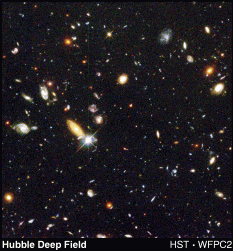
We live on the third planet from the sun
at a distance of 8.3 light minutes
(150 million kilometers or
93 million miles)
Our Place In the Universe
In the Solar System
 |
We live on the third planet from the sun |
In the Galaxy- We live in the Milky Way Galaxy. The following two artist's drawings of the Milky Way Galaxy show how our galaxy would look if viewed edge-on and face-on.
Below: Milky Way Galaxy - Edge on

Below: Milky Way Galaxy - Face on

There are about 250 billion stars in the
Milky Way Galaxy.
The Milky Way Galaxy is 100,000 light years side to
side.
The diameter of the bulge in the center is 30,000 light
years.
The thickness of the disk at the earth is 700 light years.
The solar system orbits the center every 250 million years: a galactic year
The galaxy is 13-15 billion years old
The solar system is 4.6 billion years old.
The Solar Neighborhood
Alpha Proxima is our nearest neighboring star: 4.3 light years away. It's actually one of a three-star system that includes Alpha Centaur. Two stars tumble about each other and the third star orbits those two.
How far is 4.3 light years? If you could travel really fast, say 100,000 kilometers per hour, it would take you 20,000 years to reach the closest star!
How far would the nearest str be in our model (one billionth 4.3 light years)? I wanted to include the nearest star in the Eugene Scale Model (scale one : one billion). I pictured traveling the world and placing a scale model star in some exotic foreign city. But Unfortunately the earth wasn't big enough. At a scale of one : one billionth 4 light years would be 37,869 kilometers away. The circumference of the earth is only 40,000 km. So the star would end up almost back in Eugene, only 2,131 kilometers (1,324 miles) away, but going the long way around 95% of the planet!
More about the nearest stars including:
Sirius, Alpha
Centauri, Barnard's Star, Wolf
359, BD +36 degrees 2147, Luyten
726-8, and Ross 154
The Galactic Neighborhood- The Milky Way is part of a cluster of about 30 other galaxies loosely held together by their mutual gravitational attraction. This is a small cluster, since some clusters contain thousands of galaxies.
 |
The largest galaxy in our group is called the Andromeda Spiral. A large spiral similar to the Milky Way. It is about 2.3 million light years from Earth and contains about 400 billion stars. |
 |
The third spiral galaxy in our local group, M33, is the smallest of the spirals. It is close to the Andromeda Galaxy and is thought to orbit it. |
 |
The closest known neighboring galaxies are the Magellanic Clouds, named after the famous explorer who first spotted them in 1521. In the 'clouds' are two irregular galaxies, one larger, the Large Magellanic Cloud, containing about 10 billion stars |
 |
The other is smaller and farther away: the Small Magellanic Cloud. These two galaxies actually orbit the Milky Way Galaxy.
|
More great pictures of galaxies in the Local Group
The Universe
 |
Point the Hubble Space Telescope to a tiny seemly empty patch of sky and this is what it finds: thousands of distant galaxies, remnants of the Big Bang, receding into space . |
Gravity binds stars together into galaxies, binds galaxies into local groups of galaxies, groups of galaxies into clusters, and clusters into superclusters. The number of stars in the universe boggles the mind.
Hubble Space Telescope Big site with exotic pictures of the universe.
Beyond Our Universe
If space is infinite, and how could it not be, then our Big Bang and the universe born of it, leaves a lot of space to account for. What's out there? Could be unimaginably exotic things.
In our little corner of infinity, there was a big bang event. It's not too hard to imagine the remnants of billions and billions of other big bang events clustered together in local groups, clusters, and super-clusters of big bangs.
|
|